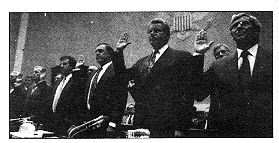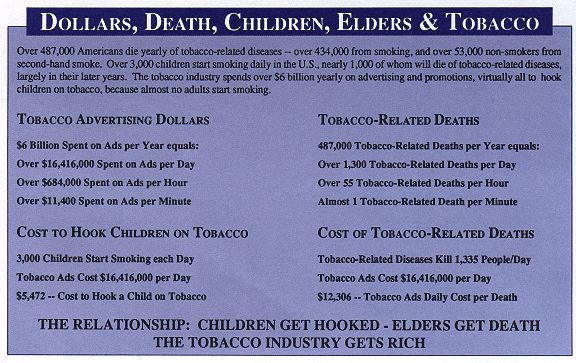"I believe that nicotine is not addictive," swore seven heads of U.S. tobacco companies before a Congressional committee on April 14, 1994.

| TOBACCO & THE ELDERLY NOTES | |
| The Center for Social Gerontology Tobacco & the Elderly Project Spring 1996 |
2307 Shelby Avenue, Ann Arbor, Michigan 48103 Tel: 734-665-1126 Fax: 734-665-2701 E-mail: tcsg@tcsg.org |
"I believe that nicotine is not addictive," swore seven heads of U.S. tobacco companies before a Congressional committee on April 14, 1994.
However, 22 years earlier, William Dunn, in a Philip Morris research paper, stated:
The cigarette is ... among the most awe-inspiring examples of the ingenuity of man....The cigarette should be conceived not as a product but as a package. The product is nicotine....Smoke is beyond question the most optimized vehicle of nicotine and the cigarette the most optimized dispenser of smoke.
That is, cigarettes are a nicotine delivery device.
On March 19, 1996, Dr. William Farone, former Philip Morris researcher, said under oath "it is well recognized within the cigarette industry that there is one principle reason why people smoke -- to experience the effects of nicotine, a known pharmacologically active constituent in tobacco."
Why the Fuss over Nicotine?
Almost daily news stories disclose new evidence that the tobacco industry knew nicotine was addictive and they manipulated levels of nicotine to keep smokers hooked. The tobacco industry denies each charge.
Yet, polls show over 90% of Americans, including over 85% of smokers, believe smoking is addictive. Moreover, 80% of Americans don't believe tobacco companies' statements. So, what's the fuss?
The stories are news for two major reasons: 1. they show that highly respected tobacco executives have, for years, deceived the public in ads and statements; 2. the scientific findings that tobacco and nicotine are addictive and tobacco companies manipulate levels of nicotine, form the legal and scientific basis for the government possibly regulating cigarettes as a drug.
But, for smokers, a major importance of these disclosures is that they provide further evidence that the tobacco industry has knowingly attempted to manipulate smokers behavior by providing levels of nicotine which will keep them addicted.
How Addictive is Nicotine?
In 1988, the Surgeon General identified nicotine as a psychoactive drug in tobacco products which was addictive just like cocaine, alcohol and heroin. Dr. John Slade, an authority on addiction, states nicotine is a drug that can be both stimulating and relaxing, depending on the state of the brain at the time.
Dr. Slade says "tolerance rapidly develops to many effects of nicotine," and "as a person learns to smoke and to use nicotine to modulate mood and feelings, the dose needed for these effects increases over a period of months to years. Gradually, the person finds that it does not feel right to be without a pack of cigarettes, and smoking becomes almost automatic, intruding on more and more parts of the daily routine."
Dr. Ian Uydess, former Philip Morris scientist, stated under oath recently: "...Philip Morris routinely applied this knowledge of selective tobacco blending to achieve desired nicotine levels in the products it designed and marketed...Philip Morris scientists understood the relationship between nicotine level and product acceptability as a result of their long history of research and experience in this area."
Of the 10 million older smokers and the 36 million younger smokers today, 2/3 say they wish they could quit. Yet, 17 million smokers try to quit each year, but only 1 out of 10 succeeds. Most smokers, 80%, say they wish they had not started.
Why do 10 million older Americans smoke?
Because tobacco advertising and promotions hooked them; and addiction held them. The good news is that quitting smoking has immediate positive health effects that can prolong life.
Preceded by a major media campaign featuring the slogan "the Camels are coming," the first modern cigarette was introduced in 1913, followed shortly by Lucky Strike and Chesterfield. At virtually the same time, new mass marketing and advertising techniques emerged. Thus began the perfect marriage of product and promotion.
When modern cigarettes were introduced, very few men, and even fewer women, smoked. As smokers know, smoking tastes bad, smells bad and irritates the eyes and throat. Tobacco barons also knew this. The question: how to attract new smokers. The answer: advertising and promotions.
Today, the tobacco industry spends over $6 billion a year on advertising and promotions. The tobacco industry maintains this is to get smokers to brand switch from one company's cigarette to another. We call that the BS theory. Less than 5 to 10& of smokers switch brands in any year.
The 1990's Joe Camel campaign to hook youth on cigarettes is highly criticized. But, tobacco ads since the 1920's, have seduced, deceived and manipulated.
The major tobacco advertising themes created in the 1920's to the 1950's live on today in the perceptions of many smokers and non-smokers.
Early on, tobacco ads attempted to deflect smokers' concerns about obvious health problems of tobacco by denying their existence. The Lucky Strike ad above denies that smoking causes throat irritation because the "toasting process expels harsh irritants." In this ad, Lucky is a women's cigarette.
The claims that tobacco caused no health problems were re-enforced constantly in the 1920's - 50's with ads featuring middle-aged male doctors (Camel ad on cover) and text explicitly and implicitly claiming that their cigarettes caused "far less irritation." In the 1960's, with increasing medical research and the first Surgeon General's report on tobacco showing the health dangers of tobacco, the tobacco ads began using "official Government statistics" to claim [falsely] that the reportedly "lower tar and nicotine" made them safer. Throughout, the ads denied tobacco caused health problems or death.
Ad themes in the 1920"s-50"s also included benign allusions to physiological effects and portrayed these as positive qualities of tobacco. Using sports and movie star endorsements, these ads touted cigarettes to: help your disposition; improve digestion; provide a 'lift;' ease tension; calm nerves; and keep women thin.
The ads also portrayed smokers as successful, glamorous, sexy, fun-loving, athletic, and patriotic. World War II ads linked tobacco with patriotism - and glamour (ad below). Cigarettes also were included in GI"s C-rations, many donated by tobacco companies,
to addict returning GI"s and create brand loyalty. One of the most successful promotional scams ever, this resulted, by war's end, in all-time high cigarette sales.
Free cigarette promotions continue as a way to hook new smokers and create brand loyalty. In the 1950"s airlines distributed sample packs on flights (see Chesterfield ad). Today, promotions tout 'buy 3 packs, get 1 free.' Or, free mini-packs are handed out on streets or at fairs - often to children.
To counter the research in the 1950's that connected tobacco with cancer, filter tips were introduced, with updated health claims that these cigarettes were safer. Ironically, Kent's 'Micronite filter' ads cited the American Medical Association as 'proof' of their safety (until the AMA forced them to stop) - these filters initially contained asbestos. By the late 1950"s, 50% of smokers had switched to filtered cigarettes, and now the figure is 98%. The power of advertising triumphed over the truth - filters don"t protect smokers.
Most persons over age 55 started smoking before 1960, since almost no one over age 20 starts smoking. By 1965, about 53% of all adult males and 34% of all adult females were smokers. Barely 50 years of deceptive, aggressive advertising had hooked almost half the adult population of America - these are today"s older Americans.
Today, about 15% of men and 12% of women, or over 4 million out of the 31 million, over 65 smoke. About 28% of men and women between 55 and 64 smoke, or about 6.2 million. Thus, almost 10 million older Americans are smokers. The lower percentage of 65+ smokers reflects many who have quit, often due to tobacco-related health problems - cancer, heart or respiratory diseases. Many also died prematurely from tobacco-related diseases.
Today, average life expectancy in the U.S. is 72 for men and 78 for women. Life expectancy of smokers is about 12 years less than that of non-smokers. One more price of tobacco advertising is lost years of life.
